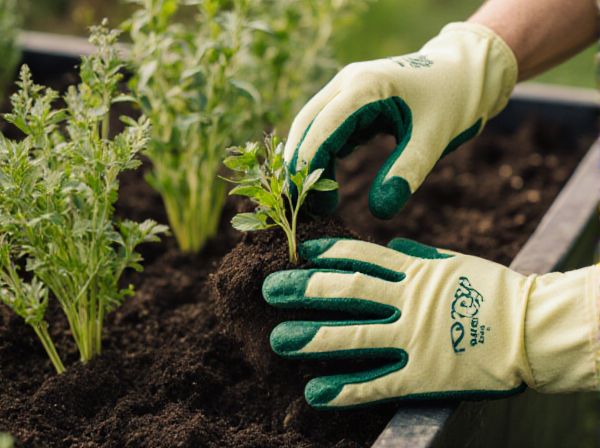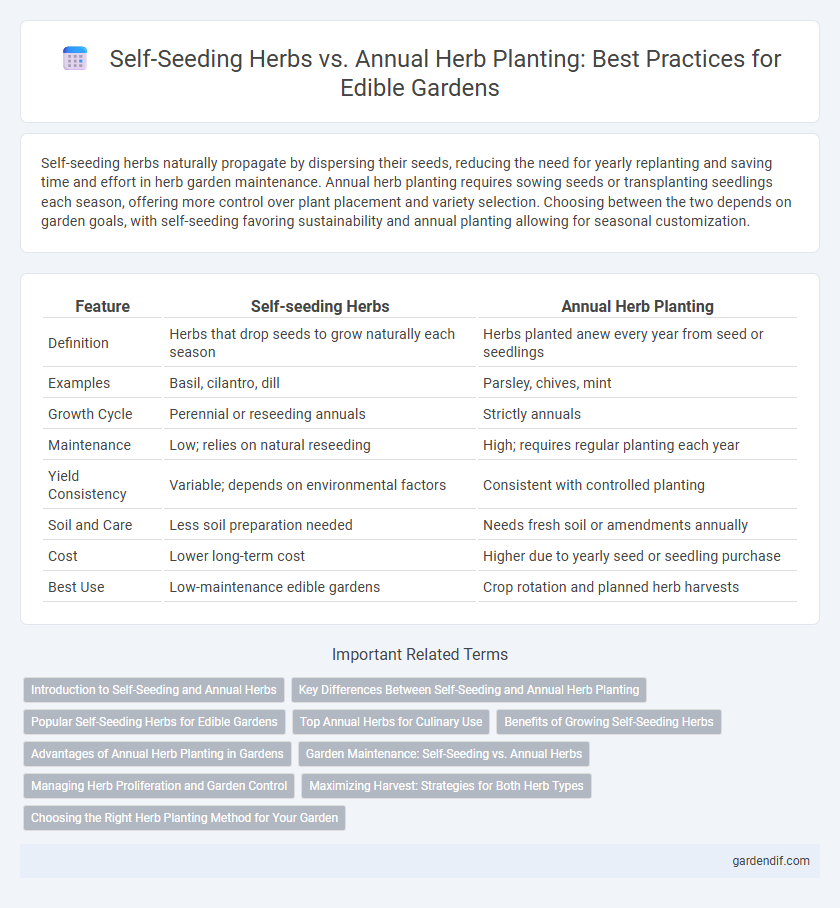
Self-seeding herbs vs Annual herb planting Illustration
Self-seeding herbs naturally propagate by dispersing their seeds, reducing the need for yearly replanting and saving time and effort in herb garden maintenance. Annual herb planting requires sowing seeds or transplanting seedlings each season, offering more control over plant placement and variety selection. Choosing between the two depends on garden goals, with self-seeding favoring sustainability and annual planting allowing for seasonal customization.
Table of Comparison
| Feature | Self-seeding Herbs | Annual Herb Planting |
|---|---|---|
| Definition | Herbs that drop seeds to grow naturally each season | Herbs planted anew every year from seed or seedlings |
| Examples | Basil, cilantro, dill | Parsley, chives, mint |
| Growth Cycle | Perennial or reseeding annuals | Strictly annuals |
| Maintenance | Low; relies on natural reseeding | High; requires regular planting each year |
| Yield Consistency | Variable; depends on environmental factors | Consistent with controlled planting |
| Soil and Care | Less soil preparation needed | Needs fresh soil or amendments annually |
| Cost | Lower long-term cost | Higher due to yearly seed or seedling purchase |
| Best Use | Low-maintenance edible gardens | Crop rotation and planned herb harvests |
Introduction to Self-Seeding and Annual Herbs
Self-seeding herbs naturally disperse seeds that grow into new plants each season, reducing the need for yearly replanting and ensuring a sustainable herb garden. Annual herbs complete their full life cycle within one growing season, necessitating fresh planting each year to maintain a consistent supply. Understanding the lifecycle differences between self-seeding herbs like thyme and chives versus annuals such as basil and cilantro is essential for efficient garden planning and maximizing harvests.
Key Differences Between Self-Seeding and Annual Herb Planting
Self-seeding herbs naturally disperse their seeds to grow new plants annually without replanting, ensuring continuous herb availability with minimal gardener intervention. Annual herb planting requires sowing seeds each season, offering control over variety selection and garden design but demanding consistent effort every year. The key differences lie in maintenance, lifecycle, and propagation method, with self-seeders providing a sustainable, low-maintenance option compared to the predictable but labor-intensive annual planting approach.
Popular Self-Seeding Herbs for Edible Gardens
Popular self-seeding herbs for edible gardens include basil, cilantro, and dill, which naturally drop seeds and regrow season after season with minimal effort. These herbs reduce the need for annual planting, saving time and maintaining consistent flavors for fresh culinary use. Gardeners benefit from the reliable spread and resilience of self-seeding varieties, ensuring a sustainable harvest.
Top Annual Herbs for Culinary Use
Top annual herbs for culinary use include basil, cilantro, dill, and parsley, prized for their vibrant flavors and fast growth cycles. Unlike self-seeding herbs, annual herbs must be replanted each season to ensure a fresh supply, as they complete their life cycle within one growing season. Regular planting of these annuals guarantees a steady harvest for cooking, enhancing dishes with aromatic and flavorful greens.
Benefits of Growing Self-Seeding Herbs
Self-seeding herbs like basil, cilantro, and parsley reduce gardening effort by naturally propagating year after year, ensuring continuous herb availability without replanting. These herbs adapt well to local conditions, promoting biodiversity and enhancing soil health through natural growth cycles. Gardeners benefit from cost savings and sustainable cultivation by allowing herbs to reseed themselves, minimizing the need for purchasing new seeds or seedlings annually.
Advantages of Annual Herb Planting in Gardens
Annual herb planting offers precise control over plant selection, ensuring gardeners can choose the freshest varieties each season to suit culinary preferences and climate conditions. This method reduces the risk of invasive self-seeding herbs spreading uncontrollably, maintaining garden aesthetics and preventing overcrowding. Regular replanting also promotes soil health by allowing crop rotation and the introduction of organic matter tailored to each herb's nutritional needs.
Garden Maintenance: Self-Seeding vs. Annual Herbs
Self-seeding herbs like cilantro and dill reduce garden maintenance by naturally reseeding each season, minimizing the need for annual replanting and constant care. In contrast, annual herbs such as basil require complete replanting each year, demanding more frequent soil preparation and watering schedules to ensure healthy growth. Choosing self-seeding varieties optimizes garden sustainability and lowers labor input, while annual herbs offer greater control over specific planting times and garden design.
Managing Herb Proliferation and Garden Control
Self-seeding herbs offer natural proliferation by dispersing seeds, reducing the need for annual replanting but requiring vigilant garden control to prevent overcrowding. Annual herb planting allows precise management of herb placement and density, minimizing competition and maintaining garden design integrity. Balancing self-seeding with selective annual planting supports sustainable herb growth and effective proliferation control in edible gardens.
Maximizing Harvest: Strategies for Both Herb Types
Self-seeding herbs such as cilantro and dill naturally propagate, reducing replanting frequency and ensuring continuous harvests with minimal effort. Annual herbs like basil require seasonal planting but benefit from planned crop rotation and succession sowing to maximize yield throughout the growing season. Implementing staggered planting schedules and optimizing soil conditions enhances productivity for both self-seeding and annual herb varieties.
Choosing the Right Herb Planting Method for Your Garden
Self-seeding herbs like dill, cilantro, and parsley naturally disperse seeds, reducing the need for yearly replanting and promoting garden sustainability. Annual herb planting offers precise control over growth cycles, optimizing yield and flavor intensity for herbs such as basil and chives. Selecting the right herb planting method depends on garden space, climate, and maintenance preferences, ensuring a thriving and productive edible garden.
Self-seeding herbs vs Annual herb planting Infographic

 gardendif.com
gardendif.com